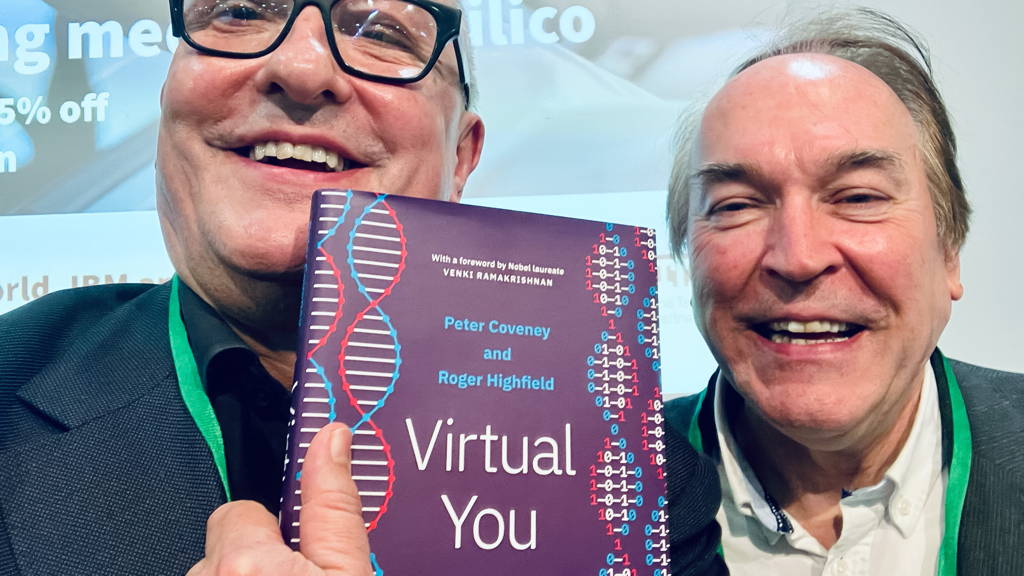Can you describe what a “virtual you” or “digital twin” is? What data is needed to create one?
Just as a weather model that runs in a powerful computer can produce forecasts of floods, droughts and storms, a computer model can produce ‘healthcasts’ of how the body will respond to a disease or treatment, whether drug, implant or surgery.
The amount of data you need to run your model depends on whether you are modeling the whole body, an organ or a molecular subsystem and what questions you ask of it: to use an analogy, if your goal is to navigate around London, then a high-resolution satellite image of the city is helpful but nowhere near as practical as a simple tube map.
Digital twins are special examples of computer models that are updated in real-time with data from the body – constant interaction between the virtual and real you produce a virtuous circle in which the model is honed by reality to produce ever better healthcasts.
Why do we actually need digital twins?
Current ‘one size fits all medicine’ is based on past data gathered on people of different genetic makeups and in different circumstances to you, so it often does not work and sometimes produces harmful side effects. Look at the years and billions wasted on drug development, for example.
Moreover, those who are biologically female or from minority ethnic groups have been relatively neglected by medical research over the past decades. If you train an AI on current medical data, for example, it will be biased in favor of white male medicine. Unlike AI trained on population data, digital twins offer the prospect of truly personalized medicine.
We still don’t know how the body and mind work. Is creating a “virtual you” a utopian vision or a close reality?
We list many examples in Virtual You where simulations are producing reliable forecasts of biological reality. Unlike AI, which blindly seeks correlations, they are based on an actual understanding of human biology. That is good news in two ways: if your model predicts how a heart beats in novel circumstances, then you know it works and how. If its predictions are wrong, then you know you need new chemistry and physics, and a model – supported by experiments – is the best way to explore these possibilities.
Your latest book, “Virtual You,” summarizes current projects on creating virtual cells, a virtual body, brain, and other organs. What’s inside for the readers?
We cover a vast number of computer models and digital twins, from simulating bacteria and cancers to screening heart drugs and planning epilepsy surgery. Perhaps the easiest way to express how much progress has been made is to say that regulators, such as the FDA, now accept simulations, and a plethora of commercial companies are working in this domain. This effort is now shifting out of the laboratory into the company and clinic.
Before reading ‘Virtual You,’ I was convinced that developing the first reasonably accurate digital twins was a matter of 10-20 years. After reading it, I think it will be at least 50 years before it happens. Am I right?
You need to define your endpoint to answer that question: yes, we will wait decades for a multiscale, multiphysics digital twin of an individual person. But even so, many applicable models are already with us.
Accurate digital twins of the human heart already exist. Bioengineer Dr Jazmín Aguado Sierra of the Barcelona Supercomputing Center created a twin of her heart, based on the Alya Red heart model and her own data, now beating in the Science Museum, London. Some companies already offer digital twin technology, such as Twinomics (acute myeloid leukemia) and ELEMBio, along with others that use this approach in medical device design and implementation, such as ANSYS and Dassault Systèmes.
It all sounds promising. How has your view of virtual twins changed after an in-depth review of current studies and initiatives while working on the book? Do you feel that “virtual us” is a near or distant future?
We did our best to provide a panoramic view of research and the foundational ideas behind this field, where Peter’s group has made important contributions.
In the few months since the book was out, we have been in huge demand at conferences around the world, from the UK to the United Arab Emirates, the US, Singapore, and China: we knew that virtual organs, notably hearts, are already being used by doctors to make clinical decisions. However, now we realize that there are major healthcare providers, notably in the US, who believe digital twins could have a significant impact more quickly than many realize.
What puzzles me is the amount of data that needs to be considered when creating a digital twin: The human body consists of somewhere between 20 quadrillion and 1 octillion molecules and around 37,2 trillion cells. Not to mention genes and billions of bacteria living in our gut influencing our physical and mental health.
The body – or, more accurately, its chemical machinery – is already routinely simulated at the molecular level, notably for drug development. And there are already whole cell simulations, too, notably of bacteria.
So, what data granularity is needed for in silico health simulations?
We dedicate a whole chapter to this question, and the answer is: to avoid the curse of Borge’s cartographers’ guild – where you attempt to model the body down to the last atom – you rely on models fed with emergent properties. These ‘higher level data’ are just as important, in fact, more critical for organ-level modeling.
Is the current computing power sufficient to run simulations of human life, or is a breakthrough such as quantum computers needed for whole human body simulations?
We can get a long way with current digital computers. However, as we argue in Virtual You, we will have to rely more on analog computing to curb the surging power demands of high-performance digital computation (exascale computers draw as much power as a small town) and deal with errors caused by using limited strings of binary numbers. When it is properly established, Quantum computing will also have a profound impact, notably on molecular simulations.
Let’s stay on the topic of errors. After decades of development of weather forecasting models, we still can only predict the weather a few days in advance. Does the same fate await health forecasting – or as you call it, healthcasts – based on digital twins?
As well as short-term weather forecasting models, we also have climate models and use ensembles of models that can make probabilistic forecasts about the Earth’s climate decades into the future.
The latter is necessarily less detailed but informs us – and the likes of the Intergovernmental Panel on Climate Change (IPCC) – how to mitigate the adverse effects of climate change. So, too, will healthcasts aim to keep individuals on the path of wellness for as long as possible and provide advance notice of any untoward health developments.
There is a big difference between weather forecasting and health forecasting: If I get wet due to an incorrect weather forecast, I will get angry, and that’s it. But if the simulation on my digital twin suggests that my health is in no danger, yet I get sick, the consequences are more serious.
Just as weather forecasts are already saving many lives on a routine basis by predicting devastating storms, so health casts will have a considerable impact on current one-size-fits-all medicine, which is hit-and-miss.
It makes more sense to use virtual organs and digital twins to make forecasts than, for example, let a doctor experiment on you or your children with a series of different cancer drugs, statins, or whatever until they eventually find one that works: rather than use patients as guinea pigs, it is quicker and better to use their digital twins instead.
Importantly, the insights of models and simulations used in digital twins are mechanistic and provide real understanding, unlike many AI models, which are black boxes that can provide accurate results with little or no insight.
Imagine that creating a precision digital twin has become possible. What simulations would you like to run on it first?
Elderly patients often have more than one disease process at work in their bodies and may also be taking an array of medications of varying efficacies, side effects, and interactions. When a relative asks what is wrong with them, doctors currently answer by listing their symptoms because they often don’t have a clear idea. A digital twin could provide real insights and give precise answers to this deceptively simple question.
What is one key takeaway from the book?
Thanks to the development of virtual organs, digital twins, and more, a new generation of truly personalized, predictive medicine is upon us.
Peter Coveney is director of the Centre for Computational Science at University College London, professor at the Informatics Institute, University of Amsterdam, and adjunct professor at the Yale School of Medicine. Roger Highfield is the science director at the Science Museum Group, a member of the Medical Research Council, and a visiting professor at University College London and the Dunn School, University of Oxford. They are the authors of Virtual You: How Building Your Digital Twin Will Revolutionize Medicine and Change Your Life, published in 2023 by Princeton University Press.







